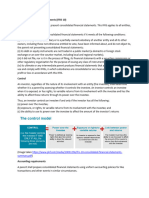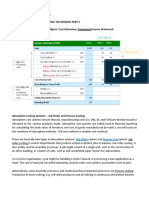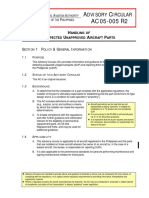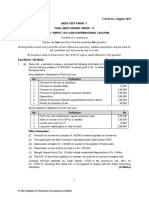Inventory Classification
Inventory Classification
Uploaded by
kamelCopyright:
Available Formats
Inventory Classification
Inventory Classification
Uploaded by
kamelOriginal Description:
Copyright
Available Formats
Share this document
Did you find this document useful?
Is this content inappropriate?
Copyright:
Available Formats
Inventory Classification
Inventory Classification
Uploaded by
kamelCopyright:
Available Formats
Guidance Material and Best Practices for Inventory Management
Section 2—Introduction to Inventory Classification
The definition of an airframe inventory is all inventory on the aircraft apart from the engine inventory,
fuselage, flight controls, landing gears, APU etc. Generally air carriers classify airframe inventory into three
types: Rotable Inventory, Repairable Inventory, and Expendable Inventory. There are three main distinctions
between these three types of inventory (see Figure 2: Inventory Classifications and Characteristics). The
first and most definitive distinction is related to scrap rate. Typically Rotables have a very low or even
negligible scrap rate and Repairables will have a scrap rate that must be considered in spares calculations,
contracts, and other planning activities. Expendables will have a 100% scrap rate as they are consumed at
the point of use and upon removal must be discarded. Scrap rate is often the key determinant in deciding
how to classify an item.
The second distinction is financial. Rotables and often Repairables are regarded by airlines as assets and
therefore are treated as such from an accounting perspective. These assets will be held on a firm’s books
and depreciated on a schedule appropriate for the asset and its parent aircraft lifespan. Expendables are
often considered assets while they are held at a central warehouse or main base, however, once issued,
they are expensed to the location receiving the Expendables. Expendables may also be held as assets until
consumed at the point of use then expensed to the department which installed or consumed the
Expendable.
Inventory Characteristics
Inventory Scrap
Classification Financial Life-cycle
Rate
Rotable Negligible Indefinite
Asset, held
on firm’s
books until
surplus or
Between 0% scrap Persists until
Repairable and 100% scrap
100%, one Consumable, Consumed at
expensed at
Expendable time use
time of issue
time of use
Figure 2. Inventory Classifications and Characteristics
4 2nd Edition 2015
Introduction to Inventory Classification
The third distinction in classifying inventory is the life-cycle characteristic. Closely related to scrap rate, the
life-cycle refers to the durability and persistence of a component once it is purchased. Rotables are
considered to be indefinitely Repairable and often persist in inventory until they are placed in surplus at fleet
retirement. With low scrap rates they can endure many years of operation, with the same asset moving
through the repair and overhaul process many times. Repairables are limited in their durability as an asset
by their scrap rate, and a certain percentage of Repairables will be continually replaced according to their
scrap rate in the repair process. As an example, consider two fictional components, one Repairable, and
one Rotable. Consider that each has an identical failure rate (MTBF-Mean Time Between Failure) to the
other. Consider also that each will be removed on average, four (4) times a year from the operating fleet.
The Rotable has a negligible scrap rate. The Repairable has a 25% scrap rate, meaning that on average
one of the four annual removals will be scrapped in the shop repair process and replaced via an inventory
purchase. The fleet is mature and has been operating for many years. Consider also that the operator owns
four (4) each of the Repairable and four (4) each of the Rotable. After four years, it is reasonable to expect
that every one of the four Repairables in inventory at the beginning of year one has been replaced due to
scrap. However, we would also expect that all four of the Rotables owned at the beginning of year one are
still in inventory. Furthermore, there have been 16 repairs or overhauls accomplished on the Rotables over
the four year period while in comparison, there have been 12 repairs or overhauls completed on the
Repairables, and four scrap replacements, although there were an identical 16 shop visits. Expendables of
course are consumed once they are installed and so persist in inventory only until they are installed.
Additionally Rotables and Repairables can also be distinct in that Rotables are more often tracked, meaning
that the components accumulate hours and cycles while Repairables are issued at time of use and most
often not tracked during their time installed in regards to hours and cycles. A maintenance computer system
might be setup as a Rotable component requiring a component change to be completed in the system while
the Repairable will only require an issue out of the inventory but no component change.
Rotables Repairables Expendables
• Wheels • Oxygen Bottles • Lamps
• Brakes • Main DC Power • Filters
• Crew Oxygen Battery • Fasteners
Mask • APU Starter, • Seals
• Radar Transceiver Electric • Gaskets
• Flight Attendant • Fire Detector • Switches
Handset • Lights • Connectors
• Altimeter • Jumpers
• Terminals
Figure 3. Examples of Commonly Allocated Parts by Material Type
2nd Edition 2015 5
Guidance Material and Best Practices for Inventory Management
Occasionally, some airlines will designate a fourth class of inventory that is termed Recoverable or
Expendable-Recoverable. Recoverables can be considered either a quasi-Expendable, or a Repairable with
a very high scrap rate. Essentially, there are some items which airlines may either throw away after use
(Expendable) but may have an approved repair developed which can return the removed Expendable to
serviceability and hence it behaves more like an Repairable. Many times the repair is merely a functional
test. Depending on the airline, Recoverable inventory may rarely be seen, instead classified as Repairable,
but with a very high scrap rate, relative to other Repairable inventory.
Delving into engine inventory, a fifth classification arises: Life Limited Part or LLP. An LLP is subject to hour
or cycle restrictions on its useful life. An High Pressure Turbine (HPT) rotor disk is an example of an LLP.
The hours or cycles are recorded and tracked by the operator to ensure compliance with approved limits.
Once an LLP has consumed its approved life, it is scrapped. Until it is scrapped, an LLP is generally
considered an asset by most accounting standards. Further, LLP inventory is further distinguished from
other assets because generally, LLPs are mutilated or destroyed at the end of their useful life to prevent
reinstallation. The mutilated LLP material can be sold for scrap as they are often made of valuable metals
such as titanium or other expensive alloys. LLP inventory can be thought of as assets like Rotables or
Repairables that eventually have a 100% scrap rate like an Expendable.
Aside from LLP inventory, engine inventory will fall into the same classification system as airframe inventory.
As such, Rotables, Repairables, and Expendables will be encountered in engine inventory and the same
conventions will apply.
Aircraft Inventory
Airframe
Engine Inventory
Inventory
Rotables Repairables Expendables Rotables Repairables LLP Expendables
Figure 4. Aircraft, Airframe, and Engine Inventory
6 2nd Edition 2015
Introduction to Inventory Classification
Note that if an airline is not actively involved in repair of its own engine assets, very little engine inventory
will be maintained with the exception of engine Line Replaceable Unit (LRU) inventory (described below). A
large majority of engine inventory is considered “gas-path” or internal to the engine. If an airline sends its
engines elsewhere for repair, generally the majority of engine related material will be provided by the repair
vendor.
One important aspect of aircraft inventory is whether it is considered as a LRU. An LRU is a Rotable,
Repairable or Expendable inventory item that can be removed and installed on the flight line. LRU inventory
can be found in airframe inventory and in engine inventory, and sometimes the distinction of engine or
airframe varies depending on the operator. Most operators will hold some engine LRU inventory even if their
engines are repaired by a vendor. If a carrier repairs its own engines, then there will be a broader spectrum
of Rotables, Repairables, and Expendables that are not LRUs held in the carrier’s inventory. Occasionally,
an operator may still own or track these assets if their maintenance is done by a third party on a time and
material basis, but per contract, the operator provides the inventory to the vendor for installation during the
repair process.
Oftentimes, LRU is used to describe a Quick Engine Change kit (QEC) and vice versa, but it is important to
note that the LRU category is much larger than the list of QEC items. QECs are developed to streamline the
installation of engines on the flight line or in a hangar environment, however, the list of QEC does not
encompass all LRUs on an engine. Keep in mind that there is an expanded list of engine LRU’s that can be
removed and replaced on the flight line due to either time-control restrictions or part failure and many of
these are not included in an engine QEC Kit. An example of an LRU that is also generally included in the
QEC is a starter. Figure 5 QEC and LRU Inventory Relationship to Engine and Airframe Inventory, though
not fully proportional shows the interrelationship between engine, airframe, LRU and QEC inventory. Often,
the QEC inventory may be a list of only a dozen parts, which the engine core always delivered to the aircraft
side with the majority of inventory installed, even though many may technically be considered LRU
inventory.
2nd Edition 2015 7
Guidance Material and Best Practices for Inventory Management
Engine
Inventory
QEC LRU
LRU
Airframe
Inventory
Figure 5. QEC and LRU Inventory Relationship to Engine and Airframe Inventory
2.1 Rotable Inventory
Rotable inventory is defined as an inventory that can be economically restored to a serviceable condition
and, in the normal course of operations, can be repeatedly rehabilitated to a fully serviceable condition over
a period approximating the life of the flight equipment to which it is related. Of course there are scrap rates
as with all inventory, however, with Rotable inventory the scrap rate is assumed to be very low, perhaps only
a few percentage points or even a fraction of a point.
Examples of Rotables are flaps, transmissions, fuel pumps, hydraulic pumps, etc. Because of their generally
high cost, Rotables are economical to repair rather than replace with new purchase upon failure. Rotables
are also generally systems made up of series of Repairable and Expendable subcomponents.
Rotables are unusual in that the repair cycle causes them to depart from mainstream notions regarding
inventory. For example, inventory is typically considered consumed upon installation, sale or other activity.
In the case of a Rotable, the inventory is generally tracked, both financially and from a compliance aspect
for its entire life.
Rotables are typically held on a firm’s books, and depreciated on a schedule that may range from 5-7 years
to 20-25 years, depending on the firm’s goals and mode of business. Some businesses, such as trading
8 2nd Edition 2015
Introduction to Inventory Classification
firms or surplus firms, may depreciate on a much more aggressive schedule of even just several years, but
typical depreciation schedules tend to follow the life cycle of the parent aircraft to which the inventory
belongs. As such, a company that leases its aircraft on a 5 year term, but purchases Rotable inventory for
operations support may depreciate on a 5 year schedule. Conversely, an airline that either purchases or
leases aircraft, but has a long term fleet plan which incorporates the parent fleet into operations for 20 years
will generally adopt a 20 year depreciation schedule for their purchased Rotable inventory.
While it is true that there is generally a scrap rate for each Rotable, the scrap rates can be so minimal as to
be inconsequential. In these cases, scrap is generally the result of incident related events, such as ground
damage to the aircraft, bird strike, Foreign Object Damage (FOD) or perhaps damage in the maintenance
process at installation, removal, or perhaps in shop maintenance. These types of events occur, but should
be relatively rare in terms of accumulated flight hours. Inventory Managers might consider excluding these
types of special events when calculating scrap rates for Rotable inventory.
2.2 Repairable Inventory
Repairable Inventory generally follows the same conventions of Rotable inventory with one important
distinction: Repairable inventory has a higher scrap rate than Rotable inventory. For example, a part may be
of the same asset value and lifespan as a comparable Rotable; however the repair process may have a
25% scrap rate.
Each airline typically defines their break-point between Rotable inventory and Repairable inventory at
different levels depending on their own economic analysis. Furthermore, some airlines may not even classify
inventory as Repairable, but only maintain the Rotable and Expendable categories. However, the
Repairable inventory classification is important to airlines and vendors of aircraft inventory because some of
the assumptions about Rotable inventory will not apply to Repairable inventory in certain situations such as
leasing, exchange agreements, loaning of parts to other airlines, or entering into pooling arrangements. The
main danger in intermixing inventory that is clearly Rotable with inventory that is clearly Repairable in nature
is that in agreements with parts vendors, maintenance providers, exchange houses, lessors, and a firm that
loans parts or any other parts interchange is that both parties should account for the scrap rate that will
certainly have an impact in long-term agreements.
One of the easier methods to deal with a huge variation in scrap rates among various part classifications is
to ensure that all parties are aware of whether the inventory in question is Rotable or Repairable, and that
scrap rates are clearly delineated between the two asset classes.
The importance of accurately representing scrap rates cannot be overemphasized as it fosters a spirit of
cooperation between client and vendor. If the scrap rates are masked or otherwise diluted via inclusion into
the overall asset pool (Rotables), agreements may be struck which over long-term are not advantageous for
either party. For in the absence of accurate scrap information, a vendor of parts, whether via leasing,
exchange, loan or pooling, will include a financial risk premium driving up the cost to the client. If the client
unwittingly misrepresents scrap rates, the operational cost will be higher than expected by the vendor,
potentially damaging the mutually beneficial long term relationship.
2nd Edition 2015 9
Guidance Material and Best Practices for Inventory Management
Another important factor for consideration of the Repairable asset class also stems from the higher scrap
rate. In the aviation industry, Replenishment Lead Time (RLT) can range from mere hours to months or
even more than a year. An example of a few hours RLT might be by acquiring a part via loan, exchange or
pool provision. An example of many months to a year might be that the part being sought has no suitable
alternative but to order direct from the manufacturer. Consider that for a Repairable item with a 25% scrap
rate, 1 in 4 removals on average will result in an order to the surplus market or to the OEM for a
replacement part. When RLT could possibly stretch into months, and the removal rates may be high, there
can be a large quantity of Repairable inventory on order at any given time and this scenario will require
close and careful management to avoid stock-outs and potential for Aircraft On Ground (AOG).
2.3 Expendable Inventory
Expendable inventory is by definition, inventory with 100% scrap rate and therefore 100% replacement for
every use. Expendable inventory often meets the criteria most laymen and financial professionals think of
when they consider inventory. Expendables range from common fasteners to filters to items which are
scrapped upon use and removal. Cost-wise, Expendables can be as expensive or more expensive than
inventory assets in the Rotable or Repairable class. Their main distinction is the 100% scrap rate.
Financially, Expendables are usually expensed at the time of use or issue, depending on the financial
dictums of the operator. Bulk items are often expensed at the time of issue to a station or maintenance
base, and this practice can induce problems that mask the true inventory levels in the operation, particularly
if there are not robust systems for inventory tracking and audit. If station visibility is lost, often planners are
induced to over order their Expendable levels, driving up Expendable balances due to the lost visibility at
stations.
Obsolescence is another issue faced very acutely in Expendable management. Because airlines usually
stock Expendables at usage plus safety stock levels, oftentimes a large quantity is on hand across the
inventory system at any given time. If a fleet is retired or engineering/ regulatory action replaces the current
Expendable part with a new one, a mass of parts is suddenly outdated and useless. One side effect is the
market value will plummet for the parts in question, and Expendables often surplus at pennies on the dollar.
As with Repairable inventory, Replenishment Lead Time (RLT) is paramount in Expendables management.
Despite their sometimes apparent simplicity, the supply chain for Expendables can be long and tedious.
Disruptions in raw material supply, manufacturing priorities, new aircraft deliveries, and a host of other
factors can cause the RLT for Expendables to fluctuate wildly. Any Expendable management theory should
take into account the variability of RLT on the expected delivery of Expendable quantities.
Generally, in most planning organizations, there is an abhorrence of flight delay or cancellation due to what
are usually considered low cost Expendables. This behaviour can lead to over-allocation and abundant
ordering. Careful Expendables management can lead to economies and cash management which will give
an airline an advantage over competitors.
Despite some of the obvious disadvantages, Expendables do have a potential benefit: lot size. Often,
Repairables and Rotables are required in lot sizes of one. However, Expendables will often be ordered in lot
10 2nd Edition 2015
Introduction to Inventory Classification
sizes much larger than one, representing several weeks or months of usage, depending on ordering
strategy. However, as an advantage, partial lots can be shipped to cover operations, with the balance
following with no negative effect to dispatch reliability. This characteristic is often the Expendable’s saving
grace when inevitable quantity shortfalls are experienced on a short-term basis.
There are multiple ways to manage the levels of Expendable inventory, including the age-old Economic
Order Quantity (EOQ). Many Expendable management methods take into account statistical theory and
other mathematical models for controlling and generating order quantities. Expendable inventory is also
ideal for vendor programs such as consignment inventory and inventory pooling. Cooperation between
operators are also possible, with an operator choosing not to stock a certain station with Expendables,
knowing this station is a base for an operator with inventory for similar fleets. However, this practice is
generally not optimized today, with most operators charging a premium based on list price to any purchaser
of an Expendable from their inventory. This intentional mark-up induces many operators to inflate their
Expendable inventory at a station, preferring the carrying cost of the inventory versus reliance on others to
stock and subsequently release inventory at what some consider to be predatory pricing. An example is that
typically Expendables will be sold to other operators by a carrier for Manufacturer Catalogue List Price
(CLP) plus a 25% mark-up.
Despite the name, Expendables are an important aspect to any operators overall inventory strategy, for a
low-cost fastener can ground an aircraft as surely as a $750,000 flap assembly. Further, careful
management of Expendable is necessary since many operators may carry one-quarter to one-third of their
overall inventory balance in Expendables. In addition, Expendables are generally tracked in lots for
traceability, facilitating the segregation of material if a part recall is issued by a manufacturer. Financially and
operationally, Expendables clearly warrant substantial attention.
2.4 Recoverable Inventory
Recoverable inventory may be a classification not commonly known or utilized. Sometimes they are referred
to as Recoverable-Expendables or similar name. An example may be a filter that has a 100% scrap rate, but
there may be a simple shop procedure which will restore the filter to serviceability on 4 in 10 filters.
The logical line between Recoverables and Expendables is generally an individual airline designation.
Recoverables can offset new purchase of Expendable items substantially via the shop reconditioning
processes, however the results can be highly variable.
Recoverables can be controversial since generally shop production of a recoverable can result in a net
credit to shop operations. It is recommended that each operator make individual Recoverable classification
decisions based on sound economic analysis.
2nd Edition 2015 11
Guidance Material and Best Practices for Inventory Management
2.5 SPEC2000 Inventory Classification
SPEC2000 is a standard administered by the Air Transport Authority (ATA) to streamline data transmission
between manufacturers, operators, and others within the aviation supply chain. Conventions are set so that
information can be exchanged clearly and concisely. One aspect of SPEC2000 is the classification of
inventory as Expendable and Repairable.
2.5.1 SPC 1
Expendable items are tagged as SPC 1 and this designation will be seen in manufacturer Recommended
Spare Parts List (RSPL) as well as T-Files and other provisioning products provided by the aircraft
manufacturer to the operator.
Note: The T-file is provided by the manufacturer to the operator in support of the component overhaul
process. Essentially, it is a Bill of Materials (BOM) for component repair and overhaul. The sub-
components listed in the T-file are generally not considered LRU.
2.5.2 SPC 2
SPC 2 denotes a Rotable spare that will have a Component Maintenance Manual (CMM) and have a listing
of sub-components within the T-file, designating an SPC 2 item as having an overhaul and repair capability.
SPC 2 items are often referred to as T-file End Items. Note that the subcomponents within the T-file will
consist of SPC 6 (Repairable) and SPC 1 (Expendable) items. SPC 2 items will generally have test, repair
and overhaul procedures contained within the CMM.
2.5.3 SPC 6
SPC 6 denotes Repairable items that may not have a CMM but are nonetheless classified as Repairables.
The clearest distinction is SPC 6 items are not T-file end items, although they are found in the T-file as sub-
components of an end item. They may be test-only once removed or there can be repairs developed by the
operator or maintenance facility. The main distinction between SPC 2 and SPC 6 is that SPC 2 items consist
of both SPC 1 and SPC 6, and both SPC 1 and SPC 6 items will be listed as sub-assemblies of and SPC 2
item in its T-file, however, SPC 6 items will not have their own T-file.
Example: Manufacturer Part Number (MPN) AC2A, keyword MOTOR, has 12 items listed within its T-File.
The AC2A is an SPC2 item, thus it is contained in a T-File. Eleven of the twelve listed items are
Expendables, SPC 1, with keywords like KIT, CONNECTOR, GEARHEAD, SLEEVE, and
ADAPTER. Only one is classified as SPC 6, and this is a motor that is a sub-assembly or sub-
component of the AC2A motor. This item, being an SPC 6, may have a test or repair but will not
have a separate T-file enumerating is BOM.
12 2nd Edition 2015
You might also like
- C9 - System Design - Activity Based CostingDocument14 pagesC9 - System Design - Activity Based Costingjose danny literatoNo ratings yet
- Inventory Costing Power Point PresentationDocument17 pagesInventory Costing Power Point PresentationMUBBASHIR . MBA(P)100% (1)
- Breakout Cost AllocationDocument41 pagesBreakout Cost AllocationijayathungaNo ratings yet
- ASC 718 Stock-Based Compensation Student)Document30 pagesASC 718 Stock-Based Compensation Student)scottyuNo ratings yet
- Chapter 15 SolutionsDocument6 pagesChapter 15 SolutionshappysparkyNo ratings yet
- Material Planning and Inventory ControlDocument7 pagesMaterial Planning and Inventory Controlsazzadasif.irlNo ratings yet
- Consolidated Financial Statement HandoutDocument9 pagesConsolidated Financial Statement HandoutMary Jane BarramedaNo ratings yet
- 9 Delivery and AcceptanceDocument3 pages9 Delivery and AcceptanceRaulJunioRamosNo ratings yet
- NC Iii-Bookkeeping Coverage and ReviewerDocument4 pagesNC Iii-Bookkeeping Coverage and ReviewerVanessa Bales MateoNo ratings yet
- PSA-706 Emphasis On Matter Paragraphs & Other Matter Paragraphs in The Independent Auditor's ReportDocument14 pagesPSA-706 Emphasis On Matter Paragraphs & Other Matter Paragraphs in The Independent Auditor's ReportcolleenyuNo ratings yet
- P1 Course NotesDocument213 pagesP1 Course NotesJohn Sue Han100% (2)
- Inventory Costing and Capacity AnalysisDocument34 pagesInventory Costing and Capacity AnalysisYel Sacriz100% (1)
- Lecture 1 - Acc204Document5 pagesLecture 1 - Acc204ALYZA NICOLE CALLEJANo ratings yet
- Corporate Governance Ownership and SustainabilityDocument9 pagesCorporate Governance Ownership and SustainabilityMitchum BaneyNo ratings yet
- ROSC Philippine 2006Document32 pagesROSC Philippine 2006Arya Guo100% (1)
- Module 1 - Fundamentals of Auditing and Assurance ServicesDocument29 pagesModule 1 - Fundamentals of Auditing and Assurance ServicesEnya ViscoNo ratings yet
- DechassaDocument54 pagesDechassakassa mnilkNo ratings yet
- Conceptual Framework and Accounting StandardsDocument142 pagesConceptual Framework and Accounting StandardsAni TubeNo ratings yet
- 01 Notes NPO WA For HasanDocument86 pages01 Notes NPO WA For HasanHassan MasoodNo ratings yet
- What Documents Are Used To Record Entries?Document7 pagesWhat Documents Are Used To Record Entries?Academe100% (1)
- Security Part I Auditing Operating Systems and NetworksDocument35 pagesSecurity Part I Auditing Operating Systems and NetworksRobert CastilloNo ratings yet
- What Is A BudgetDocument7 pagesWhat Is A BudgetMichaelNo ratings yet
- Breakeven Analysis Cost AccountingDocument6 pagesBreakeven Analysis Cost AccountingLaibaNo ratings yet
- Module 4 Purchases Part 1 and 2Document72 pagesModule 4 Purchases Part 1 and 2LUISA CARESSE FLAVIANO BRITANICONo ratings yet
- IAP Handbook Rev 9 2020-03-01 PDFDocument42 pagesIAP Handbook Rev 9 2020-03-01 PDFZain MirzaNo ratings yet
- Lesson 1 & 2 Introduction To AccountingDocument13 pagesLesson 1 & 2 Introduction To AccountingKelvin Jay Sebastian SaplaNo ratings yet
- Exam Review Question & SolutionsDocument8 pagesExam Review Question & SolutionsManish Sadhu100% (1)
- 02 Accounting For A Merchandising BusinessDocument54 pages02 Accounting For A Merchandising BusinessApril SasamNo ratings yet
- WK 1 - Cost Accounting Techniques Part 1 - HandoutDocument27 pagesWK 1 - Cost Accounting Techniques Part 1 - HandoutEENo ratings yet
- Audit Checklist For ManufacturingDocument2 pagesAudit Checklist For ManufacturingRenganathan IyengarNo ratings yet
- Wiley CPAexcel - BEC - Assessment Review - 4Document10 pagesWiley CPAexcel - BEC - Assessment Review - 4ABCNo ratings yet
- Corporate Income TaxDocument24 pagesCorporate Income TaxRIRI RUMAIZHANo ratings yet
- Session 2 - by Catherine Rose Tumbali - PPTDocument25 pagesSession 2 - by Catherine Rose Tumbali - PPTCathy TumbaliNo ratings yet
- P22 Sap ErpDocument17 pagesP22 Sap ErpPrakash CharryNo ratings yet
- Chapter 2 - Plant AssetDocument8 pagesChapter 2 - Plant AssetMelkamu Dessie TamiruNo ratings yet
- Chapter 8 Zero Rated SalesDocument39 pagesChapter 8 Zero Rated SalesCathy Marie Angela ArellanoNo ratings yet
- Chapter OneDocument36 pagesChapter Oneyiberta69No ratings yet
- CH 3 - The Statement of Financial Position and Financial DisclosuresDocument37 pagesCH 3 - The Statement of Financial Position and Financial DisclosuresZulqarnain KhokharNo ratings yet
- 9 - Segment ReportingDocument4 pages9 - Segment ReportingCathNo ratings yet
- Auditing and Assurance B Tech Level 400 Sem II 2020 Lecture NotesDocument167 pagesAuditing and Assurance B Tech Level 400 Sem II 2020 Lecture NoteslbaamagolaNo ratings yet
- Audit Solution AirlineDocument2 pagesAudit Solution AirlinemetricstreamNo ratings yet
- Intermediate Accounting 2 SyllabusDocument15 pagesIntermediate Accounting 2 SyllabusNikka Mae Socito DusabanNo ratings yet
- ACCA SA Nov12 Fau f8 Audit Procedures PDFDocument5 pagesACCA SA Nov12 Fau f8 Audit Procedures PDFআরিফা আজহারীNo ratings yet
- FAR Module 1Document7 pagesFAR Module 1Michael Angelo DawisNo ratings yet
- M10 Introduction To Business Taxation StudentsDocument33 pagesM10 Introduction To Business Taxation StudentsTokis SabaNo ratings yet
- Philippine Accounting Standard No. 1: Presentation of Financial StatementsDocument58 pagesPhilippine Accounting Standard No. 1: Presentation of Financial StatementsDark PrincessNo ratings yet
- Analysis & Interpretation of Financial StatementsDocument44 pagesAnalysis & Interpretation of Financial StatementsSecret DeityNo ratings yet
- Strategic Management Chapter 4Document32 pagesStrategic Management Chapter 4Rampant DSNo ratings yet
- Toaz - Info Instructional Material Auditing Theory 2020 PRDocument169 pagesToaz - Info Instructional Material Auditing Theory 2020 PRVeronica Rivera100% (1)
- Philippine Financial Reporting Standards: (Adopted by SEC As of December 31, 2011)Document27 pagesPhilippine Financial Reporting Standards: (Adopted by SEC As of December 31, 2011)Ana Liza MendozaNo ratings yet
- Ind AS 116Document13 pagesInd AS 116Akhil KhandelwalNo ratings yet
- IFAP SyllabusDocument110 pagesIFAP Syllabusabby bendarasNo ratings yet
- MA1 T2 MD Cost Terms Concepts and ClassificationsDocument113 pagesMA1 T2 MD Cost Terms Concepts and ClassificationsMae Ciarie YangcoNo ratings yet
- 3audit ReportsDocument67 pages3audit ReportsmuinbossNo ratings yet
- ISA 210 MindMapDocument1 pageISA 210 MindMapA R AdIL100% (1)
- Unit 5 - TRANSFER PRICINGDocument28 pagesUnit 5 - TRANSFER PRICINGRachma DiniNo ratings yet
- Bdo PresentationDocument28 pagesBdo PresentationTen Balestramon100% (1)
- Ac 05-005r2 Unapproved Parts Caap A2012Document10 pagesAc 05-005r2 Unapproved Parts Caap A2012Dharmendra Sumitra UpadhyayNo ratings yet
- Oit 999.0133-14Document9 pagesOit 999.0133-14Sa Be MirNo ratings yet
- Transfer Pricing RectifiedDocument62 pagesTransfer Pricing RectifiedAmit PirankarNo ratings yet
- Basic Concept of Inventory Management: M.G.Morshad / ACM (Electrical Maintenance) Thermal Power Station II / NLC LTDDocument15 pagesBasic Concept of Inventory Management: M.G.Morshad / ACM (Electrical Maintenance) Thermal Power Station II / NLC LTDMichael HeavisideNo ratings yet
- Business PlanDocument34 pagesBusiness PlanGen CaoNo ratings yet
- AC330 Exam Notes SampleDocument3 pagesAC330 Exam Notes SampleRicardo KlnNo ratings yet
- Just Casuals - Exit ShowDocument12 pagesJust Casuals - Exit Showunique4ahul4varshneyNo ratings yet
- Finals Conceptual Framework and Accounting Standards AnswerkeyDocument7 pagesFinals Conceptual Framework and Accounting Standards AnswerkeyMay Anne MenesesNo ratings yet
- Eval 5 Eco Ans KeyDocument3 pagesEval 5 Eco Ans KeyAlim ElmerNo ratings yet
- Test Series: August, 2018 Mock Test Paper - 1 Final (New) Course: Group - Ii Paper - 7: Direct Tax Laws & International TaxationDocument6 pagesTest Series: August, 2018 Mock Test Paper - 1 Final (New) Course: Group - Ii Paper - 7: Direct Tax Laws & International TaxationRobinxyNo ratings yet
- What Are The Support Activities of The Value Chain?Document21 pagesWhat Are The Support Activities of The Value Chain?Abigail CharlesNo ratings yet
- Dokumen PDFDocument25 pagesDokumen PDFWidya Rezkyani PutriNo ratings yet
- Berger Business ModelDocument28 pagesBerger Business ModelYash PurohitNo ratings yet
- Financial Accounting Part 7Document43 pagesFinancial Accounting Part 7dannydoly100% (2)
- A Quick Revision For NET/GSET Examination Prepared By-Anuj Bhatia Assistant Professor, Anand Institute of Business Studies ContactDocument26 pagesA Quick Revision For NET/GSET Examination Prepared By-Anuj Bhatia Assistant Professor, Anand Institute of Business Studies ContactPankaj KhindriaNo ratings yet
- Ia3 AssignmentDocument8 pagesIa3 AssignmentRed VelvetNo ratings yet
- Executive Summary: A. IntroductionDocument9 pagesExecutive Summary: A. IntroductionKathleen Mae Amada - TorresNo ratings yet
- Audit of Property, Plant and Equipment: Auditing ProblemsDocument5 pagesAudit of Property, Plant and Equipment: Auditing ProblemsLei PangilinanNo ratings yet
- Financial Accounting and Reporting-IIDocument7 pagesFinancial Accounting and Reporting-IIRochak ShresthaNo ratings yet
- FM Assignment (Ashutosh Karan-L118)Document21 pagesFM Assignment (Ashutosh Karan-L118)Chaitanya BhujadeNo ratings yet
- Chapter 4 MDocument39 pagesChapter 4 MAhmed El KhateebNo ratings yet
- Cambridge Assessment International Education: Accounting 9706/32 May/June 2018Document17 pagesCambridge Assessment International Education: Accounting 9706/32 May/June 2018Tesa RudangtaNo ratings yet
- SAP FI HighlightsDocument28 pagesSAP FI Highlightsejas.cbitNo ratings yet
- BSBMKG501 Assessment 2Document15 pagesBSBMKG501 Assessment 2Divya JoshiNo ratings yet
- Ais ExerciseDocument26 pagesAis ExerciseLele DongNo ratings yet
- Exam 20062011Document7 pagesExam 20062011Rabah ElmasriNo ratings yet
- Chapter 7 Macroeconomic MeasurDocument1 pageChapter 7 Macroeconomic MeasurKathleen CornistaNo ratings yet
- JowanDocument3 pagesJowanKyree VladeNo ratings yet
- Toa 2Document16 pagesToa 2Ray Jhon OrtizNo ratings yet
- R2R QuestionsDocument17 pagesR2R Questionsgupta6891100% (1)
- BoJ Project FInance Third EditionDocument142 pagesBoJ Project FInance Third EditionbagirNo ratings yet
- Glosario de Ingles BancarioDocument53 pagesGlosario de Ingles BancarioGabriela SuárezNo ratings yet
- Advanced Corporate FinanceDocument134 pagesAdvanced Corporate Financecaro.colcerasaNo ratings yet

























































































